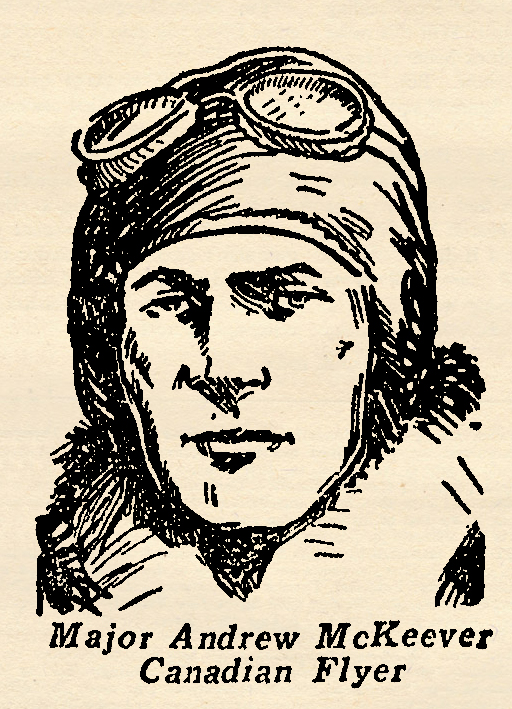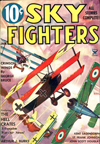My Most Thrilling Sky Fight: Major Andrew McKeever
AMIDST all the great pulp thrills and features in Sky Fighters, they ran a true story feature collected by Ace Williams wherein famous War Aces would tell actual true accounts of thrilling moments in their fighting lives! This time we have Canadian Air Ace Major Andrew McKeever!
Andrew Edward McKeever  was one of the many daring young sky fighters that came from Canada to add fame and lustre to the deeds and exploits of the Royal Air Force, He put in almost a full year in the infantry before he was transferred for flying training. He joined the R.F.C. in December, 1916, was commissioned a lieutenant and sent over to the 11th Observation Squadron in France on May 16th, 1917.
was one of the many daring young sky fighters that came from Canada to add fame and lustre to the deeds and exploits of the Royal Air Force, He put in almost a full year in the infantry before he was transferred for flying training. He joined the R.F.C. in December, 1916, was commissioned a lieutenant and sent over to the 11th Observation Squadron in France on May 16th, 1917.
As a two-seater fighter he was without a peer. Beginning his career of victories just as he turned 19, this brilliant young man brought down his first enemy aircraft a month after he went to the front. When the war ended he was credited with 30 official victories, more than any other two-seater pilot in any other army.
He won the British D.S.O. and M.C, and the French conferred upon him the Croix de Guerre. He survived the war without ever receiving so much as a scratch in sky battles, only to be killed in an automobile accident in his home town on Christmas Day in 1918. The story below is his own account of a battle with 9 Huns 60 miles behind the enemy lines.
TWO HUNS WITH ONE BURST
by Major Andrew McKeever • Sky Fighters, February 1936
IT WAS soupy weather when my observer and I took off. There was a drizzling rain and the clouds over the trenches were almost on the ground. But H.Q. had ordered a picture of an ammunition dump 60 miles behind the lines. I volunteered to get it, and took advantage of the soupy weather in sneaking into Hunland. All the way in we saw no Huns. And we saw none at the dump. I flew above the clouds all the way by compass, and nearing what I thought should be my destination I dropped down through a hole in the clouds to get my picture. Odd as it sounds, I was right over the ammunition dump. Flying without sight of the ground I had hit the target of my flight right on the bull’s-eye.
The pictures were easy to get. My observer snapped them at 500 feet altitude, then we turned back for the long trip home, only to be met by 9 Huns, who had apparently been waiting for us. Two of them were painted a brilliant red. The other seven were black. They lost no time attacking when we turned for our own lines.
“Shall I run for it, or shall we try to fight them off?” I yelled back through the phones at my observer. “They’ve got the speed on us,” he shot back. “We can’t run. We have got to fight!”
His own guns were stuttering even before he finished, and tracer from the leading Hun attacker, a red Pfalz, was clipping through my upper center section. I lifted the Bristol’s nose and aimed for the Hun’s belly as he shot over me. I had time for just one short burst. But it was enough for that Pfalz. It went over and nosed into the ground, bursting in flames when it crashed. Gilbert, my observer, kept the Huns from sitting on my tail as I split-aired and dove for the other red Pfalz. A black Fokker cut across behind the Pfalz just as I fired. The Pfalz pilot wilted if his seat. My burst almost tore his head off. His ship went down, spinning erratically.
But the strangest thing was that the Fokker behind him fell apart in the sky at the same instant. One wing came off and fluttered down slowly. The fuselage and other wing sank like a plummet. That single burst of mine had passed through the Pfalz pilot’s head and sheared the Fokker’s wing off.
Gilbert, meanwhile had got one of the Fokkers, trying to attack from the rear. But two more pounced in on him, while I dived for one below me. There was terrific clatter and I looked over my shoulder toward the back pit. I couldn’t see Gilbert. I turned back again to get my sights on the Fokker and spray out a burst. It never came out of the nose dive it was in, just hurled on into the ground. I looked back again, and was relieved to see Gilbert standing in the back pit. But he was pointing at his Lewis guns. They were useless. A Spandau burst had wrecked them completely.
I swung around again and went for a persistent Fokker who was trying to get at me from below. I got my sights on him and pressed the trips. But it was no go! My guns didn’t answer. I reached up to clear what I thought was a jam. But it was worse than a jam. The whole breech had been shot away. My own gun had been rendered useless while I was staring at Gilbert’s.
We couldn’t fight any longer, so I ran for it. We hedge hopped in and out of the clouds all the 60 miles back, with those four Fokkers hi-tailing after us. But the clouds served in good stead. The Fokkers followed me right to the drome, and didn’t leave until I sat down.
Death whispered in our ears all the way back, but my old Bristol had just enough speed to keep one jump ahead of the grim spectre. It was my hardest and longest fight . . . and closest shave. I don’t want any more like it. And for once Gilbert agreed with me.








